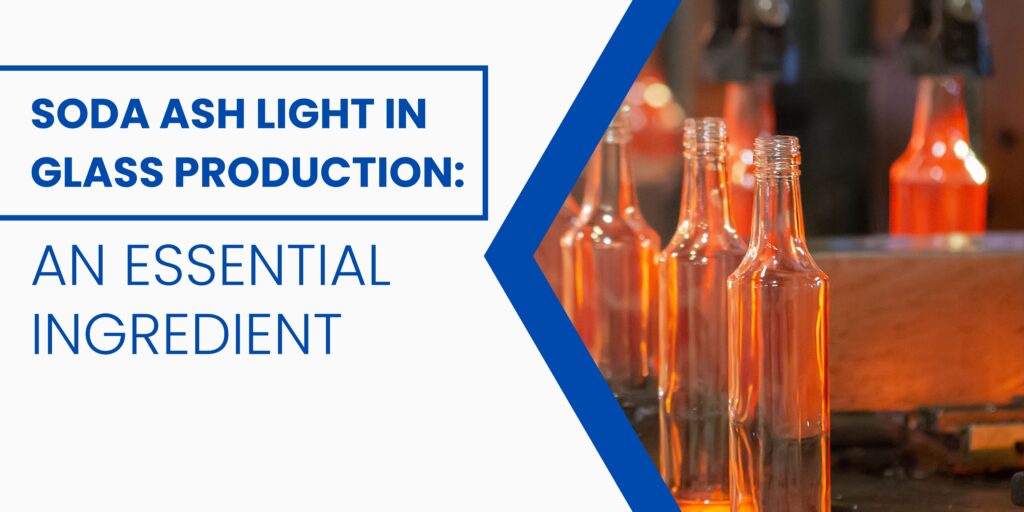
Glass, a timeless substance, seamlessly blends beauty and functionality. It forms the windows we look through, the bottles we drink from, and the screens we interact with daily. But the creation of glass is a sophisticated and multifaceted process, with each ingredient contributing significantly to its distinct properties and versatility. Among these components, soda ash light emerges as a pivotal ingredient, molding the character of glass and expanding its range of uses.
This comprehensive article embarks on an exploration of the realm of glass production, diving deep into the pivotal role of soda ash light in creating this remarkable material. We will cover the journey from the historical origins of glassmaking to the latest innovative techniques and evolving environmental considerations. Moreover, we’ll delve into the unique properties of soda ash light, which render it indispensable in the glass industry.
Glass: A Journey of Utility and Beauty
Glass, as we know it today, is an extraordinary substance that seamlessly blends utility and beauty. Its transparency and malleability have enabled its use in a vast array of applications, from architecture to telecommunications. But the story of glass extends far back in history. It has been a witness to human evolution, from its humble beginnings as rudimentary beads and jewelry to the sophisticated glass we use in our smartphones and skyscrapers. The ubiquity of glass in our daily lives makes it a material worth exploring in-depth.
Glass is not a simple substance; it’s a symphony of ingredients that come together in a harmonious blend. Silica, soda ash light, limestone, and various other elements are combined to create the different types of glass we encounter. Understanding the role of each ingredient in this composition is crucial in comprehending the intricacies of glassmaking and appreciating the significance of soda ash light in this process.
Evolution of Glassmaking
Antiquity to Artistry: The Beginnings of Glass
The earliest glass artifacts date back to 3500 BCE in Mesopotamia, but they weren’t the clear glass we are familiar with today. These artifacts were typically opaque or colored and used mainly for decorative purposes. Over time, the secrets of creating clear, transparent glass were unlocked, leading to a new era in glass production.

Medieval Mastery: The Crucible of Glassmaking
The medieval period marked significant advancements in glassmaking techniques. Innovations such as the use of lead in glass compositions and the creation of stained glass windows in cathedrals brought a newfound appreciation for glass both as an art form and as a functional material.
Industrial Alchemy: The Impact of the Industrial Revolution
The Industrial Revolution brought about a revolution in the glass industry. Mass production techniques, the development of the glassblowing pipe, and the invention of the glass bottle significantly expanded the accessibility and uses of glass. This period of industrial alchemy set the stage for glass to become a ubiquitous material in the modern world.
Modern Glass Manufacturing Techniques
The Float Glass Revolution: A Pane of Progress
The float glass process, developed in the mid-20th century, revolutionized the production of flat glass. It involves floating molten glass on a bed of molten tin, resulting in an incredibly flat and distortion-free surface. This process is used to produce the sheets of glass for windows, mirrors, and more.
Bottles, Jars, and Beyond: Container Glass Production
Soda ash light plays a pivotal role in container glass production. This type of glass is known for its durability and its ability to retain the flavor and freshness of the contents. Whether it’s a glass jar containing grandma’s homemade jam or a bottle of fine wine, soda ash light contributes to the integrity of the container.
From Fiber Optics to Eyeglasses: Specialized Glass Manufacturing
Specialty glasses like borosilicate, known for its exceptional thermal resistance, and optical glass, used in lenses and fiber optics, demand precision and expertise in manufacturing. Soda ash light’s role in these glasses varies, and its presence is often essential to achieving desired properties.
The Role of Soda Ash Light in Glass Production
Understanding soda ash light begins with distinguishing it from other soda ash variants. Soda ash light, chemically known as sodium carbonate, boasts unique characteristics that set it apart. Its high purity, alkalinity, and solubility in water make it particularly effective in glass formulations. It stabilizes and homogenizes glass melts, ensuring the resulting glass is both durable and clear. It plays a fundamental role in the soda-lime-silica system, which forms the basis for most everyday glass products, such as windows, containers, and more.
Soda Ash Light in Glass Batch Formulation
Mixing the Glass Batch
The art of glass batch formulation involves meticulous precision. The careful blending of raw materials, including soda ash light, silica sand, and other components, is a critical step. This amalgamation is akin to creating a culinary masterpiece, where the proportions and the sequence in which these ingredients are added significantly impact the final product. Soda ash light, in this symphony of elements, plays a role akin to a seasoning that enhances the overall flavor.
The Melting Process
The melting process of glass is akin to a transformational journey. Soda ash light, with its distinct chemical properties, is a key catalyst in this metamorphosis. As the batch melts, soda ash light lowers the melting temperature of the silica, allowing it to transition from a solid to a molten state. The result is a glassy matrix that can be shaped into a myriad of forms, from intricate art pieces to utilitarian containers.
Shaping the Glass Character
Glass properties are not a one-size-fits-all affair. The type and quantity of soda ash light used in the batch significantly impact the glass’s properties. Higher concentrations of soda ash light can yield a more workable glass, while variations in type can affect its durability and chemical resistance. This fine-tuning enables glassmakers to create products that meet specific requirements, whether for delicate ornaments or durable windows.
Environmental Considerations in Glassmaking
The glass industry is increasingly conscious of its environmental footprint. Energy-efficient technologies, such as regenerative furnaces, reduce energy consumption and production costs. Emission control technologies, like electrostatic precipitators and baghouses, minimize the release of pollutants into the atmosphere. Recycling initiatives within the glass industry reduce the need for new raw materials and lower waste and emissions.
Innovations in Glass Production
From Clear to Clever: Advanced Glass Technologies
Glass is no longer just transparent; it’s now “smart.” Innovations in the industry have given rise to technologies like smart glass, which can switch from clear to opaque on demand, and bendable displays, which are revolutionizing the world of electronics. These cutting-edge applications showcase the continuous evolution and adaptability of glass.
The Circular Symphony: Recycling and Sustainability
Sustainability extends beyond production techniques. The glass industry is also committed to recycling and reducing its environmental impact. The circular economy model of reusing glass products, such as bottles and containers, not only conserves resources but also reduces waste and emissions, creating a win-win situation for both the industry and the environment.
A Glimpse into the Future: Innovations on the Horizon
The integration of nanotechnology with glass holds immense promise. Researchers are exploring the use of nanoparticles to enhance the strength and purity of glass, opening up new possibilities in various industries. Bioglass and eco-friendly initiatives are transforming the glass industry into a greener and more sustainable sector, reducing environmental impact.
Conclusion
In the vast world of glass production, soda ash light emerges as an unassuming yet indispensable ingredient. Its unique properties, from high purity to alkalinity, make it a catalyst for shaping the versatile material we encounter in our daily lives. From the earliest beads in Mesopotamia to the towering skyscrapers of modern cities, the journey of glassmaking has been nothing short of remarkable. The symphony of ingredients that go into creating glass, with soda ash light as a pivotal note, is a testament to human ingenuity and craftsmanship.
As we reflect on the enduring significance of soda ash light, we discover that it is more than just a chemical compound; it is a key to unlocking the potential of glass. From the environmental consciousness of the industry to the innovations that promise a brighter and more sustainable future, the world of glass production continues to evolve. Whether it’s the artistic expressions of glass sculptors or the sleek designs of modern architects, glass continues to enchant, protect, and inspire. In Soda Ash Light, we find an unsung hero that has contributed to the beauty, utility, and innovation that surrounds us, and its role remains as vital as ever in shaping the glass of tomorrow.




